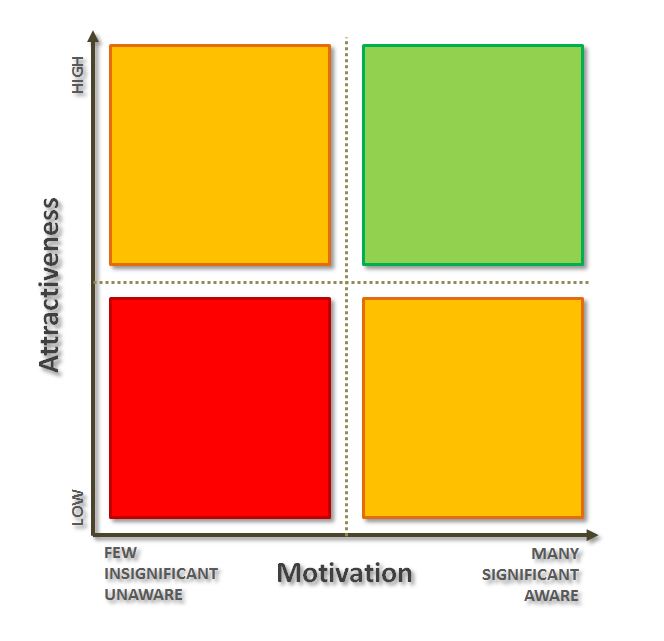
One of the areas salespeople spend an incredible amount of time is on the transition of prospects to clients. Many things cause salespeople (and sales leaders) angst in this process.
Prospects which, whilst making the right noises, never present an opportunity. Prospects who you can never close. Prospects which you win and then wish you hadn’t. It is demonstrated by a funnel in which the top doesn’t shift. It stagnates no matter how much you put in.
Our clients and prospects seemingly always want to negotiate the price down and features up while we, as salespeople, wish to protect our margins and volumes. It is always a tension rich situation. There are existing relationships in play – sometimes these work in our favour, sometimes they don’t. Inertia features heavily.
As a result, many salespeople defer to simply farming their existing clients for more business, rather than finding new clients. However, the same issues can present themselves, albeit more discreetly. Because we already earn money from our existing clients, our failed prospecting activities to generate more from them are hidden. We don’t see that we are failing here.
It’s obvious when we are working with prospects as we don’t yet earn any revenue from them – so not being successful here is plain to see. But the same failure happens with our clients – it can just be disguised.
Prospecting for new business is a difficult activity – but in reality it is the core job a salesperson is hired for. Whilst the below is focused on acquiring new business, it can equally apply to growing the business of existing clients.
How do we go about it?

Attractiveness
It starts with a clear understanding of what our ideal clients look like. Based on what we do, how we do it and why we do it, what are the 5 characteristics that make up our ideal clients? How do you describe your ideal clients? Can you?
If you don’t know what your ideal client looks like – how can you discern a great prospect from an average (or worse) one?
This can be by industry, by size, values, structure; whatever, but you need to determine what your ideal client looks like.
Why 5 characteristics? Well, any more than this and you risk describing anyone, not the right ones. Sure, you may need more at times or less – but the key here is ensuring you are distilling this down to your key features of your ideal client.
The reality is, whilst you are describing your ideal client – if you get this correct, you are also describing their ideal supplier/partner. This is why this step is important – this is about identifying which of your potential prospects you can deliver the most value to through working together.
It doesn’t mean you avoid anyone who doesn’t meet these criteria – but it means you make a conscious decision to work with them if you choose to. It also allows you to prioritise prospects when you have execution capacity shortages.
It’s also worth pointing out that this requires constant assessment throughout the prospecting cycle as you learn more about your prospects. As you uncover more information, this may determine whether they become more or less attractive.
Similarly, you need to constantly refine these criteria as both you, your market and your prospects change. What was ideal yesterday is by no means certain to be ideal tomorrow.
The next part of the assessment of attractiveness is the potential opportunity. Whilst the client themselves may be attractive, the opportunity that presents itself may not be. It’s easy to fall into the trap of doing a seemingly easy, but unattractive piece of work for an ideal client, for a favour or to gather goodwill. But do so with your eyes open as the question you need to ask is whether you’ll upset your relationship with an ideal client over a less than ideal opportunity to do business with them.
Attractiveness could be paraphrased as your own motivation, as you are far more likely to move mountains for a highly attractive prospect and opportunity than you are for one that isn’t.
Motivation
Nothing is more frustrating than having a great relationship with an ideal prospect which never goes anywhere. Sales pipelines everywhere are full of them. Somehow you get ‘friend-zoned’ through the process as someone they like, but seemingly never do business with.
Have you questioned their motivation? What is their motivation to move to you?
Most prospects/clients will either do something to dissolve pain or resolve opportunity. There are always challenges competing for attention in your prospect’s business. What you need to determine is the level of their motivation to do something about it. You need to consider:
Aware v Unaware
As sales professionals, we will often uncover opportunities or risks in a prospect’s business that they aren’t yet aware of. Of course, before that prospect is going to get anywhere near motivated enough to do something about it, are they aware of it? Making a prospect aware of a potential risk or opportunity in their business is hugely beneficial to your relationship to them. It proves you’re an advisor; that you know their business enough to open their eyes to something that can make it better. However, until you do this, they are highly unlikely to do anything about it. Selling before you’ve done this will just result in them not listening.
The first step to motivating your client is making them aware of the pain or opportunity, and quantifying the value of resolving it.
Significant v Insignificant
Not every opportunity is of the same materiality to your prospect. Other priorities can dwarf the one you are trying to help them realise, or it can simply just be something which is there, but not worrisome enough to do anything about. Your prospects motivation to do something about the pain or opportunity will be directly correlated to its significance. For low significance opportunities, unless you can change your prospect’s perception of its importance, you are likely to encounter a prospect with a very low motivation to proceed.
A great example of this is why price usually only becomes an issue after a service failing. A catastrophe of service is usually more significant than price.
Few v Many
A single issue may not warrant your prospects attention enough to motivate them to do anything about it. Many issues will usually get that attention. When looking at your prospect, ask yourself: what are their triggers to move? Do they have one or many? The more impetus they have to move, the greater the likelihood that they will.
This is often why simply rolling in with price doesn’t work – you’re pulling on one lever only.
If you start to assess your opportunities with your prospects against the two criteria of attractiveness and motivation – you’ll quickly form a plan around how better to motivate them to action and win more attractive business in doing so.
There are some things to be mindful of here though. The lower left hand quadrant can be a graveyard for salespeople/teams. A prospect that is of low attractiveness coupled with them having little motivation to move? Why spend time here? Unless something can or does change – this is not an area a salesperson or team should be playing. You run the risk that it takes a long time to win mediocre business.
Also, the lower right hand quadrant can either be considered low hanging fruit or a poisoned chalice. You must ask: why are they motivated if they are of low attractiveness? You can pick up great business here – but you also risk picking up prospects who are running from something rather than to something.
The upper left quadrant is about managing relationships. You have identified them as attractive but, as yet, they aren’t highly motivated to move. You need to either maintain and deepen that relationship until they are, or work with them to alter their motivation through further discovery and value assessment.
Prospecting is undeniably one of the hard aspects of selling – but when executed well, it is also one of the most enjoyable. This is especially the case when you have a potential client highly motivated to realise an opportunity and you have identified them as some you really wish to work with. Hopefully by better qualifying your prospects, you can benefit from higher quality relationships, a more wholesome sales pipeline and happier clients and salespeople.
Words by Dan Symons, development professional, sales leader and mentor at Sales Deconstructed.








